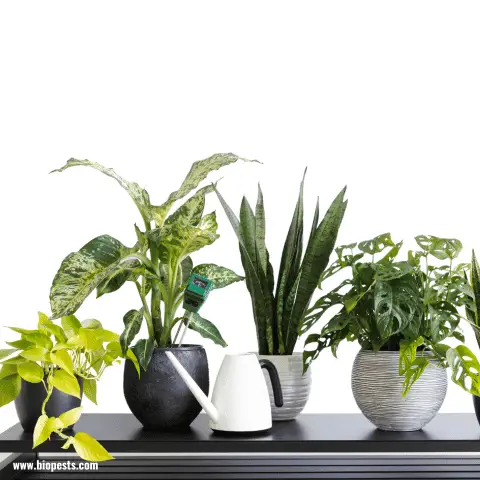Are you looking for an office plant that will thrive despite being stuck in an artificial light environment? Or maybe one that doesn’t attract pesky insects like aphids or spider mites to your workspace? Are you looking for an EASY-TO-GROW plant?
You’ve come to the right place!
In this blog post, I am going to share 10 of the best office plants available that are both pest resistant and capable of flourishing under artificial lighting – ensuring your workspace remains healthy, happy, and lively! So if you want some greenery without having to worry about annoying bugs crashing your party, keep reading!
Working in an office with no windows or very little light can be tough, particularly if you are someone who loves to surround yourself with nature.
But worry not! There are plenty of easy-to-grow, pest-resistant plants out there that thrive in artificial light and low-light environments. These plants don’t mind the fluorescent light of your office and can provide a sense of calmness and freshness to your workspace.
Let’s go through our list of plants and discover their unique characteristics together. You’ll be surprised how much just a little bit of nature can do to boost your spirits and enhance your productivity!
Pothos Plants
Plant scientific name: Pothos
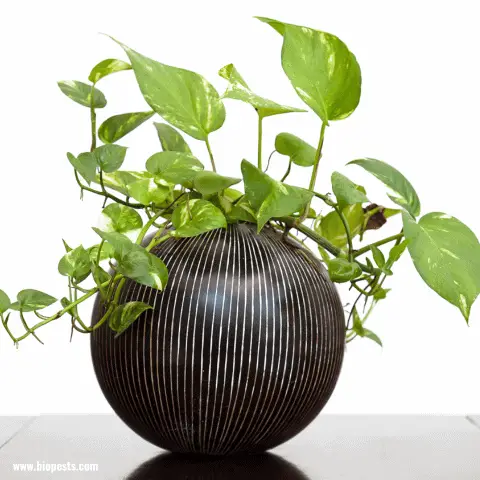
If you’re new to the world of indoor plant care, pothos is a great place to start. It is one of the easiest plants to grow and can thrive in just about any environment – including your office.
While there are many different types of pothos plants, two of the most common are the Golden Pothos and the Marble Queen Pothos. One of the best things about pothos plants is that they don’t require much care, making it ideal for those who are busy or simply don’t have a green thumb. Plus, this plant is highly pest resistant, so you won’t have to worry about any unwanted visitors making a home in your greenery. And if you’re looking for a stylish way to display your golden pothos, consider using a hanging basket. This plant grows quickly, so you’ll have a beautiful cascade of healthy foliage in no time.
These plants love bright, indirect sunlight (but also thrive with artificial light – they are this amazing!) and grow well in temperatures between 65-85°F. Watering your pothos is also an important aspect of its care; letting the soil dry out slightly between waterings is essential, ensuring that the roots don’t become waterlogged. If the leaves start to yellow, it’s a sign that the soil is staying too wet. If the leaves are wilted or drooping, that’s a sign that it’s time to give them a drink. Pothos plants enjoy a good trim now and then, so don’t be afraid to prune them back if they get too unruly. With just a bit of attention and love, your pothos plant will thrive in no time!
Plant Tip: What’s my secret to making my office warm, welcoming, and green? Pothos plants! They’re my go-to “space fillers” when my imagination or budget runs low. These versatile plants are so affordable and easy on the eyes that I buy a bunch to add life to my workspace without breaking the bank. You should try it too!
Snake Plant
Plant scientific name: Dracaena trifasciata
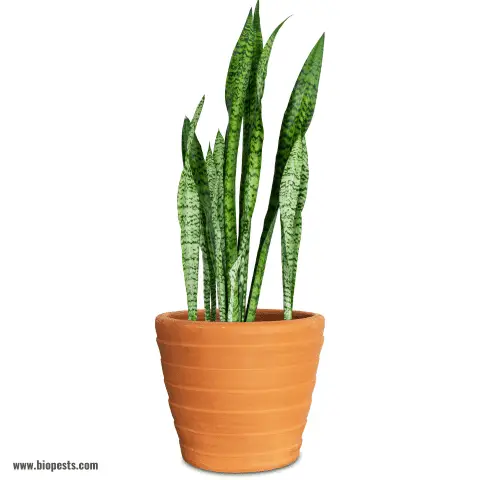
You can’t go wrong with the timeless beauty of snake plants! These stylish and hardy houseplants are perfect for beginners and seasoned green thumbs alike.
Snake plants are incredibly resilient! Their leaves are pest-proof and practically indestructible. No need to worry about unwanted critters taking over – these plants can handle anything thrown their way. Try them out today and see for yourself why they’re the perfect addition to any office.
Forgetful? No problem! The ultimate low-maintenance plant, snake plants are perfect for people who are short on time and don’t have a green thumb. Needing minimal watering, they’re happy to grow in low-light conditions, even if you put them in the shadowiest corner of your office. Thriving with neglect, snake plants are a dream come true for busy individuals who still want to bring the beauty of nature into their workspace.
Peace lily
Plant scientific name: Spathiphyllum
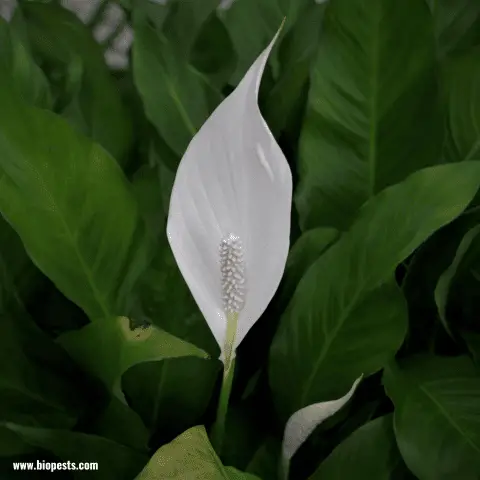
Another classic. This plant can thrive in artificial and low light, making it the perfect addition to those darker corners of your home.
Their strikingly beautiful flowers are both elegant and graceful, making them a focal point in any room. With their lush green foliage and lovely white blooms, peace lilies bring a calming and peaceful atmosphere to your surroundings. Not only do they have an aesthetic appeal, but they are also easy to care for. Proper watering and indirect sunlight are all they need to thrive.
Not only is the peace lily easy on the eyes, but it’s also pest resistant, making it a hassle-free addition to your plant family. The peace lily rarely sees an unwelcome bug or critter. However, it’s not entirely immune to these pests, with mealybugs, aphids, and spider mites being the most common offenders.
Acting fast and diligently is your ticket to keeping these invaders at bay. The secret ingredient? Rubbing alcohol. Not only is it easily accessible, but it’s also a strong deterrent against these pesky bugs. Just be sure to use a gentle touch when rubbing down those leaves, as the peace lily is a delicate plant.
Check out my article on common plant pests and learn how rubbing alcohol can be your secret weapon to plant success.
If alcohol is not an option, you might also want to check how to make your own insecticidal spray. I wrote another article on that.
Plant Tip: If you want to encourage more blooms, simply place the plant in a brighter spot!
Dracaena
Plant scientific name: Dracaena
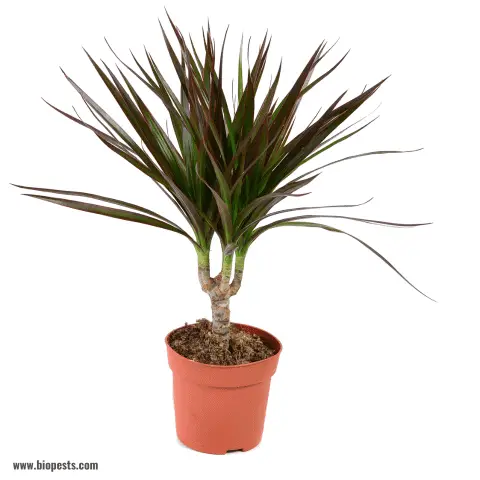
If you’re a beginner in the world of indoor plants, dracaena is a fantastic choice to get started! This African beauty is incredibly low maintenance, making it perfect for those who are just dipping their toes into the world of plant care.
One of the best things about Dracaena is that it thrives in low-light environments, so it’s perfect for apartments or offices with limited natural light. And if you’re concerned about not having enough light, don’t worry! Dracaena can also tolerate artificial light, making it a versatile option. If you’re worried about pests damaging your plants, you’ll be happy to know that dracaena is naturally pest-resistant. Another thing to keep in mind is that Dracaena fears overwatering, so make sure to let the soil dry out between waterings. With these tips in mind, you’ll be well on your way to enjoying a beautiful and healthy dracaena plant in your office!
Spider Plant
Plant scientific name: Chlorophytum comosum
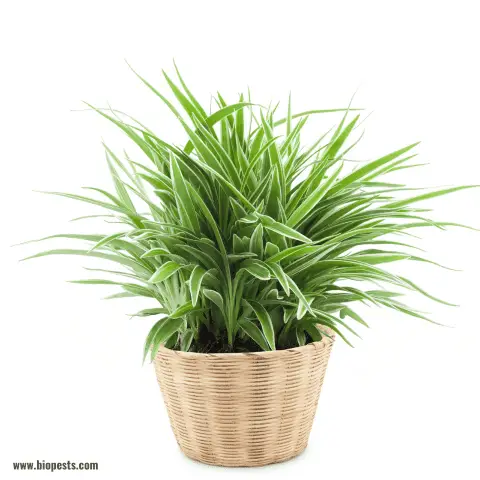
Spider plants are a great addition to any office, not only because they’re easy to care for, but also because they add a tropical vibe to your living space. They’re pest resistant, which makes them a low-maintenance plant option.
Firstly, ensure your spider plant is receiving adequate water and avoid watering it with fluoridated water. Also, be mindful of brown tips indicating overwatering or lack of humidity. Remember, spider plants prefer low light, so keep them away from direct sunlight; otherwise, they will get brown tips or scorched leaves. By following these care instructions, you’ll have a green and bushy spider plant in no time. Don’t be afraid to experiment with styling and placement; let your creativity shine!
Plant Tip: Sometimes, Spider plants can become leggy. As I wrote in this article, there are a few simple tricks to make your spider plant bushier.
Zanzibar Gem (also known as ZZ Plant)
Plant scientific name: Zamioculcas zamiifolia
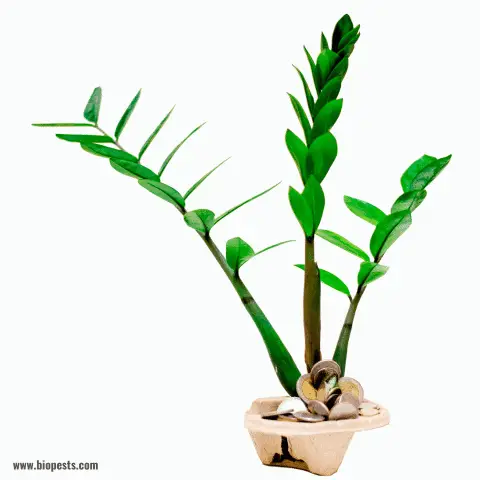
If you’re looking for a low-maintenance indoor plant that looks great and is easy to care for, the ZZ plant might be just perfect for you. This plant is resilient, making it great for busy office workers or those who have a history of killing their plants. Caring for a ZZ plant is simple as long as you follow a few basic guidelines.
The plant thrives in bright, indirect light and well-draining soil, so be sure to place it in a spot where it can get enough light without being subjected to direct sunlight. When it comes to watering, ZZ plants only need to be watered about once every week or two, so just keep an eye on the soil and make sure it doesn’t become too dry. Lastly, keep an eye out for pests such as spider mites or mealybugs, but don’t worry too much – these pests are easy to deal with if caught early. Overall, if you’re looking for a low-maintenance, beautiful plant to add to your office, the ZZ plant is definitely one worth considering!
Keep in mind; this plant is toxic to humans and pets.
Plant Tip: This plant has shiny, glossy green leaves that bring a nice touch of nature to any space with minimal effort. In order to keep the ZZ plant leaves clean and dust-free, simply take a damp cloth and gently wipe the leaves to remove any dust build-up (but please do NOT use chemical products as they can clog the leaves’ pores). You can also use a sprayer to lightly mist the plant, which doubles as a way to hydrate its leaves.
Cast Iron Plant
Plant scientific name: Aspidistra elatior
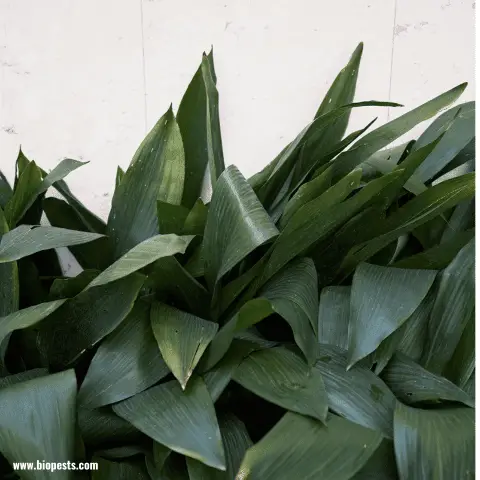
The Die Hard of all plants… Caring for a cast iron plant may seem daunting, but it’s actually quite simple! This plant is incredibly low-maintenance and pest resistant. When it comes to lighting, cast iron plants are quite adaptable and can thrive in both bright and low-light conditions. However, they do require well-draining soil and consistent watering. The key is to allow the soil to dry out a bit between watering to avoid overwatering and root rot. If you’re worried about not having enough natural light for your cast iron plant, don’t worry: it can also thrive with artificial light. Remember, this plant likes to take its time and grow at its own pace. Patience is key, as it won’t become a lush bush overnight. But trust me; the wait is worth it!
With just a bit of attention and care, your cast iron plant can become a beloved member of your plant collection.
Chinese Evergreen Plant
Plant scientific name: Aglaonema
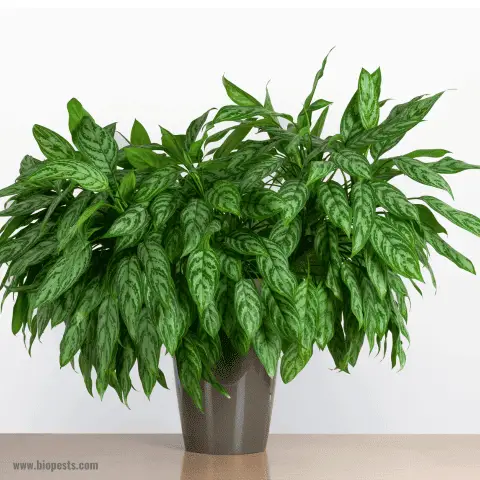
If you’re looking for a low-maintenance houseplant that’s easy to care for, then the Chinese Evergreen plant is an excellent choice. These plants are known for their striking foliage, which comes in a variety of shades of green, silver, and white, and their ability to thrive in low-light conditions. Chinese Evergreens can adapt to a range of indoor environments, but they do best in bright, indirect light. They need a well-draining soil mix and should be watered when the top inch of soil has dried out. Be sure to watch out for the most common pests like spider mites and mealybugs – but with regular maintenance, your Chinese Evergreen should do just fine. If you don’t have access to ample natural light, artificial light can be used to supplement. With these growing tips, you’ll be sure to have a healthy and happy Chinese Evergreen.
English Ivy
Plant scientific name: Hedera helix
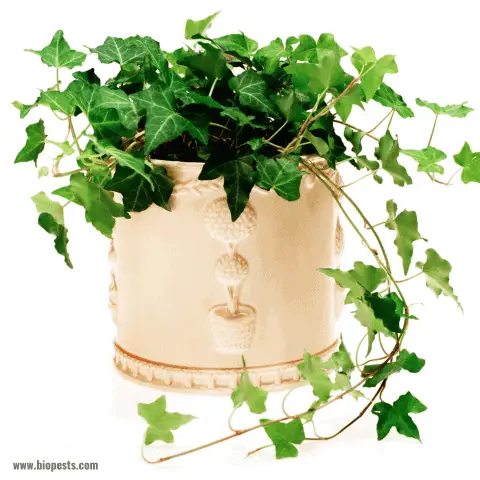
If you’re looking for a low-maintenance houseplant, the English Ivy plant should be at the top of your list! These plants can add a touch of sophistication to your home or garden with their vibrant green hues and intricate shapes. Not only is it a beautiful addition to any home or office, but it also helps purify the air. One of the most important things to keep in mind when caring for an English Ivy plant is its light requirements. These plants prefer bright, indirect light but can also thrive under artificial light. When it comes to soil, English Ivy plants are not picky and can do well in a variety of soils as long as they are well-draining.
It’s important to keep the humidity levels in check to ensure your English ivy thrives. Aim to maintain a humidity level of around 50 percent. While it’s important not to overwater your English ivy, you also don’t want it to dry out completely. Check the soil every few days and water the plant when the top inch feels dry.
This plant is relatively resistant, however, pests such as spider mites and scale insects are the most common culprits. They can be easily avoided with routine maintenance. With a little love and care, your English Ivy plant will be a beautiful addition to your home for years to come!
Peacock plant
Plant scientific name: Calathea Makoyana
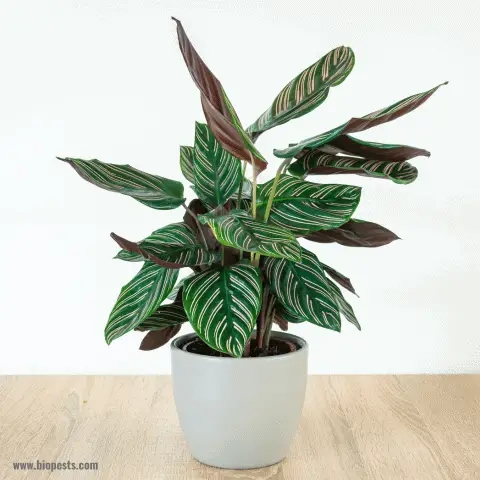
Looking to add a unique touch to your indoor jungle? Look no further than the Peacock Plant! This leafy tropical beauty features stunning patterns of greens, pinks, and purples that resemble the feathers of a peacock. To keep your Peacock Plant thriving, consider the tips below.
Ensure the soil is well-draining and enriched with plenty of organic matter.
Keep the humidity high by misting regularly or placing a tray of water nearby. Avoid direct sunlight, as these plants prefer moderate to low light conditions. Common pests to watch out for include spider mites and thrips, so keep a lookout for any signs of infestation. With proper care, your Peacock Plant will continue to dazzle for years to come.
We hope this article has given you some great ideas for some amazing office plants that will add life to your workspace. Pest-resistant, easy to grow, and thrive in low or artificial light, these ten plants are sure to give your office the perfect balance of greenery and functionality.
Whether you choose one or all, we’re sure they’ll bring a certain level of energy and freshness that can contribute to an enjoyable workspace.
Make sure not to forget about them once you launch into work… caring for your plant friends can be a great way to stay connected with yourself and nature even as you plug away at tasks. It can also create a feeling of satisfaction that comes from being able to nurture something even amidst all the stress and hectic pace of modern professional life.
Some of the links above are affiliate links, meaning at no additional cost to you, I will earn a commission if you click through and make a purchase.

